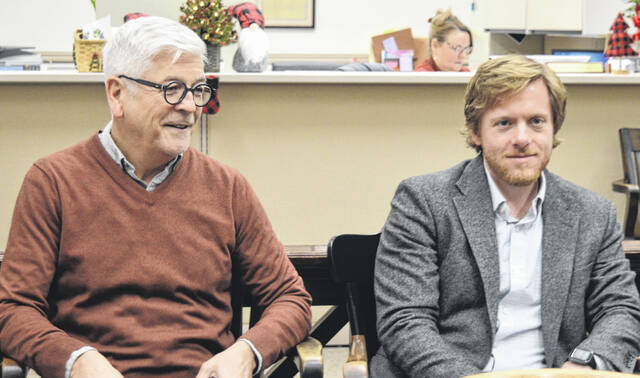
WILMINGTON — County officials are looking at possible water or sewer improvements at the two local I-71 interchanges for development opportunities.
The consulting services firm IBI Group performed a study to evaluate options to provide public water and sewer services for the village of Port William, as well as options to provide the same two services for the area at State Route 73 and Interstate 71.
Clinton County Commissioners President Mike McCarty has said if you’re wanting to get a public water or sewer project done, he feels “it’s kind of a ripe environment” given the state and federal funding that’s out there now.
Currently, Port William has neither a public water system nor a municipal sewer collection system.
The SR 73/I-71 area does not have public sewer, but the Western Water Co. does go through the area providing water although it doesn’t have lines to connect to all residents.
A sewer option for Port William, and expanded water service around SR 73/I-71 might be the most achievable of the four projects evaluated, according to IBI Group consultants.
The Port William sewer option would involve putting sewers within the village and running a sewer line to the R+L wastewater treatment plant, said consultant Kevin Wood, an IBI Group associate director \ principal in Water Resources Engineering. R+L headquarters are near the I-71 and U.S. 68 interchange.
This project would require the County or other public entity to own the wastewater treatment plant and necessitate the plant’s treatment capacity be at least doubled.
This project’s estimated capital cost — the cost to design and construct the system — is $5.1 million.
The SR 73/I-71 option would require an agreement with Western Water Co. plus the construction of a new 500,000-gallons water storage tank to have fire suppression.
This project’s estimated capital cost is $3.9 million.
In addition to the three county commissioners, there were several other local leaders at Wood’s recent presentation.
Clinton County Regional Planning Commission Executive Director Taylor Stuckert said interchange development is a core component of the future growth strategy as spelled out in the county’s comprehensive plan.
“We’re fortunate to have two of them [I-71 interchanges] in our county,” said Stuckert. When planners think about things from a vantage point of the regional metro level, “those are assets that we have to invest in,” he added.
Clinton County Port Authority Executive Director Dan Evers said if there aren’t proactive steps taken, then at a certain point an Interstate highway interchange will be filled with store-and-locks and gas stations with their own septic tanks for sewer.
Clinton County Economic Development Director Jennifer Klus Ekey spoke in favor of the county’s comprehensive plan as something everyone can get behind and look to as a path forward. She noted it identifies areas for growth and opportunities, and can help direct how such conversations go.
Evers said that anecdotally, interchange development sites with sufficient or substantial water and sewer capacity develop, and moreover tend to develop relatively quickly if the owners of those properties want to have them developed.
Wood mentioned the passage this fall of a large federal infrastructure bill, adding those funds will start coming to Ohio next year and be distributed over five years.
If one or more of the water and sewer projects in Clinton County are pursued, it would take a while to line up necessary funding, said Wood. He added a project would not be taken to the construction phase until there is enough funding lined up so that customers would have reasonable monthly rates to cover operational costs and the debt payment.
The Ohio Development Water Authority has established an unsewered communities grant that’s specifically “for these last, small pockets that are unsewered” that amount to half a million to a million dollars, he said.
“I think Port William would be a perfect example of a community that would qualify for that grant,” Wood told commissioners.
If public sewer is installed within a community, every structure within 200 or 250 feet of the main line is required to connect in, Wood said.
Among the four projects the IBI Group evaluated the largest price tag, by far, is a sewer project at SR 73/I-71 at an estimated $13.4 million. The other three projects all fall within the range of $3.9 to $5.1 million.
Another factor to consider in the decision-making process is that commissioners also very much want to expand broadband access in the county.
Commissioners in October selected the firm Ice Miller Whiteboard to come up with short- and long-term strategies for broadband expansion throughout the county, a process that’s ongoing.
Reach Gary Huffenberger at 937-556-5768.


